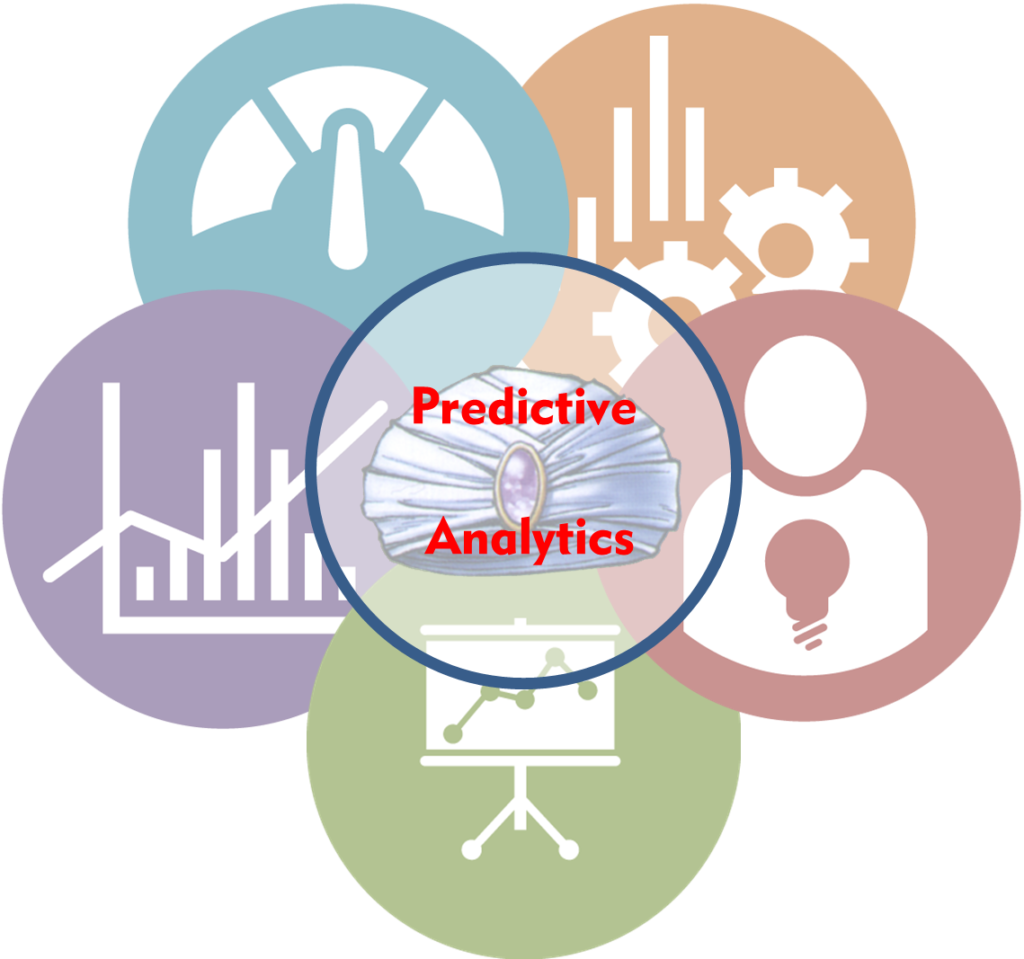Predictive analytics is a topic you are likely to hear a lot more about in the years ahead. Predictive analytics involve techniques like data mining and machine learning to predict future trends from current data. You might be asking yourself, “What is the difference between traditional forecasting and predictive analytics? Don’t both activities involve using available data to estimate what a potential future state is going to be?” The two activities are related. Organizers at Predictive Analytics World explain the difference this way: “Predictive analytics [goes] beyond standard forecasting by producing a predictive score for each customer or other organizational element. In contrast, forecasting provides overall aggregate estimates, such as the total number of purchases next quarter. For example, forecasting might estimate the total number of ice cream cones to be purchased in a certain region, while predictive analytics tells you which individual customers are likely to buy an ice cream cone.”[1] In other words, granularity is the primary difference between forecasting and predictive analytics.
Predictive analytics are another tool in the kit that decision makers can use to help improve the choices they have to make. SAP explains, “Best-run organizations empower increasing numbers of employees with real-time business intelligence, which provides relevant insights to drive informed decisions and actions.”[2] The article continues, “From strategy to planning and execution, alignment across the organization provides decision makers with critical visibility into trends. With the ability to simulate conditions, decision makers can model changes based on future projections, making decisions to adjust to changing global and local environments.” Being able to adjust business decisions to changing local and global environments is really the key concept behind why companies need to consider adopting predictive analytics techniques.
Enterra Solutions® is an SAP Partner so we are obviously interested in what SAP offers to its clients. SAP notes, “With predictive analytics solutions from SAP, you can build predictive models to gain unprecedented insight into your customers — from acquisition through cross-sell, up-sell, churn prevention, and generally taking the next best action with every interaction, across every customer channel.” SAP reports that its clients have used its predictive analytics solutions to achieve the following types of results:
- More targeted and effective promotions and campaigns, increasing usage of value-added services.
- Better insight into both large and small communities of interest.
- Precise, accurate, and fast polling of big data to identify customer-related issues, including propensity to purchase, likelihood of churn, and prospective credit risks.
- Identifying market gaps, turning them into revenue.
- Matching of customer eligibility, inventory availability, and profitability to prioritize offer presentations and deploy a next-best-activity solution.
- Campaign optimization to maximize retention, cross-sell, and up-sell across marketing channels, and increasing revenue.
- Proactive identification and targeting of customers at risk of churning well before the loss.
- Creating forecasts for assortment planning, shelf replenishment, pricing and promotion analysis, store clustering, store location selection, and sales and purchasing planning.
- Achieving better accuracy in sales forecasts.
Dave Blanchard (@supplychainDave) reports that some companies are using predictive analytics to significantly improve supply chain demand planning.[3] He explains:
“Not that long ago, supply chain visibility tended to be an internally-focused process, one that allowed manufacturers to know when exactly they could expect to receive inbound goods and materials from their suppliers so they could plan and adjust their production schedules. While that’s still an important capability for companies to have, the Age of the Consumer has shifted the focus of visibility initiatives in the direction of the customers. Manufacturers still need a complete view of their supply chain as it exists now, of course, but just as crucial is being able to know where their supply chain needs to be. And that’s where predictive analytics come into play.”
Blanchard reports that Bill Abernathy, head of North America product supply logistics excellence at Bayer CropScience, told an audience at ProMat 2015, “Predictive analytics are changing consumer buying behavior, and supply chain professionals need to be able to satisfy the increasing demands of consumers who expect products delivered exactly when promised.” Blanchard adds, “By applying advanced statistical analysis of structured and unstructured data sources (i.e., Big Data) to identify patterns and predict future events, manufacturers using predictive analytics gain the ability to make better decisions that anticipate what their customers are asking for now, and will be asking for in the future.” That is also the conclusion of a report released by MHI and Deloitte. George Prest (@mhi_ceo), CEO of MHI, told the ProMat 2015 audience, “The speed at which supply chain innovation is being adopted — coupled with rising consumer expectations for anytime, anywhere service — is stressing traditional supply chains to near-breaking points. Companies that continue to use traditional supply chain models will struggle to remain competitive and deliver orders that are accurate and on-time.” In spite of the apparent advantages of using predictive analytics, according to the MHI/Deloitte study, “less than 25% of companies have adopted predictive analytics to date, though that number is expected to climb to 70% over the next three to five years.”
In another use case for predictive analytics, “Melbourne-based cargo company, RightShip, is turning to predictive analytics to more accurately assess if ships are ready to be sent out to sea.”[4] Rebecca Merrett (@Rebecca_Merrett), reports that Bryan Guenther, systems manager of RightShip, told the audience at the Predictive Analytics World event in San Francisco, “I may be talking about the maritime industry but this is something that can relate to lots of things. Credit card companies, for example, take a look at risk, so they do very similar vetting to what we do here. … Through real predictive analytics we can find out and measure exactly what type of risk that [a factor] really poses.”[5] In another article, Merrett reports that Beat Schwegler (@cloudbeatsch), director of cloud evangelism at Microsoft, told the audience at the YOW! Developer Conference in Sydney that predictive analytics could be used for activities as diverse as helping consumers decide when to purchase airline tickets or allowing companies to pre-emptively take action (e.g., knowing that a particular piece of machinery is about to fail).
As predictive analytics become more mainstream, the uses that companies will find for these techniques will dramatically increase. The rise Internet of Things will also make predictive analytics more impactful in the years ahead.
Footnotes
[1] Predictive Analytics World, “Predictive Analytics World FAQ“.
[2] SAP, “Predictive Analytics: Customer Successes,” SAP, 2014.
[3] Dave Blanchard, “Predictive Analytics Let Manufacturers See More Clearly into their Supply Chains,” IndustryWeek, 27 March 2015.
[4] Rebecca Merrett, “Predictive analytics ensures ships stay in shipshape for cargo company,” CIO, 1 April 2015.
[5] Ibid.
[6] Rebecca Merrett, “Machine learning and predictive modelling 101,” TechWorld, 16 December 2014.





